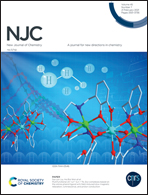A novel copper ion sensing fluorescent probe for fast detection of pyrophosphate and alkaline phosphatase†
Abstract
A fluorescent probe with high selectivity for the detection of copper ions (Cu2+) is synthesized using 4-hydroxyhypoxidone, paraformaldehyde and proline via a one-step Mannich reaction. This Cu2+ fluorescent probe with large Stokes shift (129 nm) has good water solubility and could coordinate with Cu2+. It achieves fluorescence of this probe to be quenched linearly with the increasing concentration of Cu2+ from 10 to 800 nM. Since Cu2+ and pyrophosphate (PPi) have a stronger coordination ability, it promotes Cu2+ to coordinate with PPi preferentially and results in the fluorescence of the system being enhanced again. In this way, a novel fluorescence “turn-on” detection of PPi in the range from 2 to 40 μM within 2 min is developed using this Cu2+ fluorescent probe. It exhibits high selectivity in PPi detection towards other anions such as Cl−, NO3−, CO32−, PO43− and SO42−. It is worth noting that PPi can be hydrolyzed into phosphate (Pi) by alkaline phosphatase (ALP), and the coordination between Cu2+ and Pi is not as strong as that with the probe. Herein the fluorescence of the system can be quenched again after the addition of ALP. A fluorescence “turn-off” detection of ALP from 10 to 90 mU L−1 is achieved using this Cu2+ fluorescent probe. When it is used to detect ALP in serum samples, recoveries from 98.5% to 104.2% are obtained.



 Please wait while we load your content...
Please wait while we load your content...